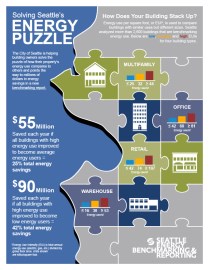by Shane Henson — January 20, 2014— Seattle, Washington, has joined the growing list of U.S. cities that are publishing detailed reports on building energy use in an effort to motivate property owners to make their buildings more efficient, and to ultimately save energy and money.
A new report and infographic released by Seattle’s Office of Sustainability and Environment on building energy use reveal that Seattle building owners are poised to save tens of millions of dollars on energy annually by improving their buildings’ energy efficiency. Seattle also recently released its Resource Conservation Management Plan, which sets guidelines for reducing energy use in city-owned buildings 20 percent by 2020.
“Seattle has the right experience, local talent and programs in place to make all our buildings more energy efficient,” said Sustainability and Environment Director Jill Simmons. “Improving building energy efficiency benefits the entire city by lowering energy costs, reducing carbon emissions, and making Seattle an even more attractive place to live and work.”

This infographic gives Seattle FMs an idea of how their facilities stack up against similar facilities in terms of energy efficiency.
(Click on image to enlarge)
The report, 2011/2012 Seattle Building Energy Benchmarking Analysis Report, summarizes the benchmarking results of more than 2,600 private-sector buildings representing nearly 228 million square feet, including offices, hotels, apartment buildings, retail stores, religious and educational institutions and more. Building owners provided energy use information to the city as required under the City of Seattle’s Building Energy Benchmarking and Reporting Ordinance.
To help Seattle owners see how their buildings’ energy use stacks up to that of their peers, the analysis and report established performance ranges for 13 different building types based on their reported 2012 energy use. For example:
- An office building reporting an energy use intensity (EUI or energy use per square foot annually) of 60 kbtu/sf is about average for Seattle.
- Multifamily (apartment and condo) buildings, which tend to use less energy than offices, had an average EUI of about 32 kbtu/sf.
According to the report, if all the highest energy users improved to the average level of efficiency for their building type, owners would save a combined $55 million on utility bills each year and lower annual energy use by an average of 25 percent across all buildings. Also, if these same buildings improved to match the energy efficiency levels of the best-performing buildings in their class, utility bill savings would surpass $90 million each year, and annual energy use would decline by an average of 42 percent.
Many businesses have already begun implementing changes based on the benchmarking program.
“Thanks to the Seattle benchmarking program, we are now regularly tracking our energy use and finding new ways to save energy and money,” said Bob Anderson, CEO of Seattle’s Horizon House retirement community.
After benchmarking its buildings, Horizon House staff and residents went on to make energy-saving improvements to the complex, which have saved them $80,000 on utility bills over the last two years, says the Seattle Office of Sustainability and Environment.





